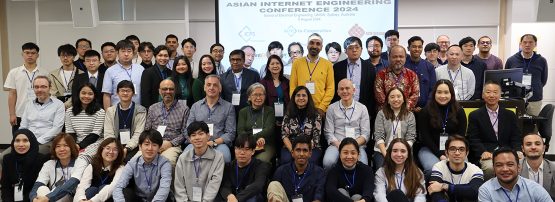
I had the privilege of attending the 19th Asian Internet Engineering Conference (AINTEC 2024), held in conjunction with the Association for Computing Machinery’s Special Interest Group on Data Communications (ACM SIGCOMM) at the University of New South Wales (UNSW), in Sydney, Australia.
AINTEC is a diverse conference and workshop series organized by Kanchana Kanchanasut with the support of InterLab. Typically held over two days in various locations across the Asia Pacific region, this year’s event was condensed into a single day to accommodate participants attending SIGCOMM meetings. With significant participation from undergraduates, postgraduates, and early-career postdocs, this change was a smart decision, enabling them to engage more fully with both events. Essentially, for the cost of one meeting, they had the opportunity to attend two. AINTEC 2024 was generously supported by ACM, InterLab, THnic, the Internet Society, WIDE, and the APNIC Foundation.
AINTEC maintains a rigorous peer-review process, and the papers and poster session presentations selected by this year’s program committee were consistently high quality. Here are a few highlights from my perspective.
Measuring GenAI Usage Patterns in a University Campus via Network Traffic Analysis by Minzhao Lyu, Yifan Wang, and Vijay Sivaraman (UNSW).
This paper explores methods to assess GenAI usage levels from PCAP packet captures on the campus network. A model of query-response sizes and complexity, along with the time-series behaviour of individual user sessions, was developed and applied to the observed packet sequences. There was no risk of exposing PII from the GenAI sessions, as they are almost universally protected by QUIC or TLS (HTTPS). This means neither the nature of the queries nor the responses could be identified, except for image generation, which had notably larger response sizes as the generated images were transmitted. An increase in GPT usage was observed near exam periods, possibly related to revision, comprehension, or coding assistance during design exercises using embedded tools.
Dynamic Fixed-point Values in eBPF: a Case for Fully In-kernel Anomaly Detection by Atsuya Osaki (Keio University), Manuel Poisson (CentraleSupélec, Inria), Seiki Makino (Keio University), Ryusei Shiiba (Sokendai), Kensuke Fukuda (NII/Sokendai), Tadashi Okoshi, and Jin Nakazawa (Keio University).
This paper examines an adjustment to the encoding of float values in the eBPF mechanism. Representing floats within the kernel involves risks, and the fixed-point method models floating-point values using integer representation, though with tradeoffs in accuracy. The paper explored a more dynamic approach that allows precision and scale to be adjusted based on the context, maintaining both speed and accuracy while adhering to kernel runtime constraints.
bypass4netns: Accelerating TCP/IP Communications in Rootless Containers by Naoki Matsumoto (Kyoto University) and Akihiro Suda (NTT R&D).
Containerization has become essential, but the efficiency of the network stack has been visibly impacted by the multiple layers packets must traverse — from the bare-metal card to the intermediate processing layers, and finally to the virtualized container. This paper presents a stack modification that significantly improves TCP/IP performance and is compatible with both statically and dynamically linked container code, unlike some alternatives that rely on changes to LD_PRELOAD. It works independently of both Podman and Docker, with the potential for full integration into their future releases. For now, it is available as a separate installation to be added to container descriptions and builds. This work won the Best Paper Award.
The Quest for a Resilient Internet Access in a Constrained Geopolitical Environment Nowmay Opalinski (University Paris 8), Zartash Afzal Uzmi (LUMS University), and Frédérick Douzet (University Paris 8).
This paper examined the vulnerabilities of Pakistan’s national Internet connectivity, both from internal and external perspectives, highlighting its reliance on just two agencies for global Internet access. Despite having physical cross-connects to India, Pakistan depends on two subsea fibre cables for all traffic to the Middle East, Europe, and Asia. Over the past 22 years, these cables have experienced more than 20 cuts. Nowmay presented compelling graphics illustrating the centrality of service dependency and comparing Pakistan’s situation to other economies worldwide.
I want to highlight one of the 17 posters, titled Implementing Non-Public 5G Networks Using Open-Source Software and Off-the-Shelf Hardware, by Chatchamon Phoojaroenchanachai and Apichart Intarapanich (NSTDA), which was supported by the APNIC Foundation.

This was the fourth AINTEC meeting I’ve had the pleasure of attending, and they continue to be truly engaging. The attendees are always sharp and ready to participate. Well done to the program committee for assembling such an interesting event. I’m already looking forward to the next one! AINTEC 2025 will be held in Manila, Philippines.
The views expressed by the authors of this blog are their own and do not necessarily reflect the views of APNIC. Please note a Code of Conduct applies to this blog.
